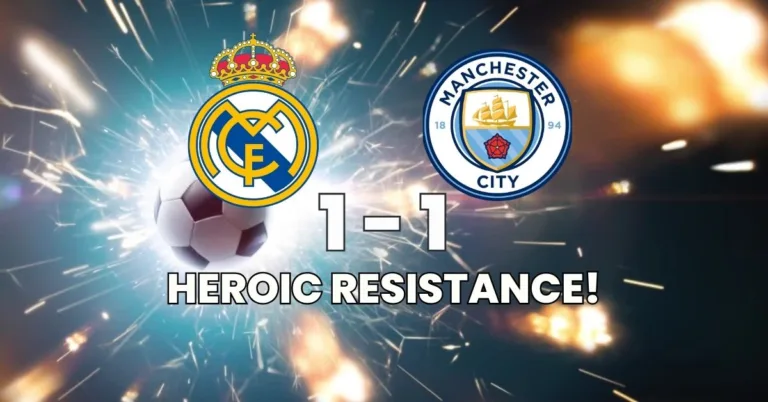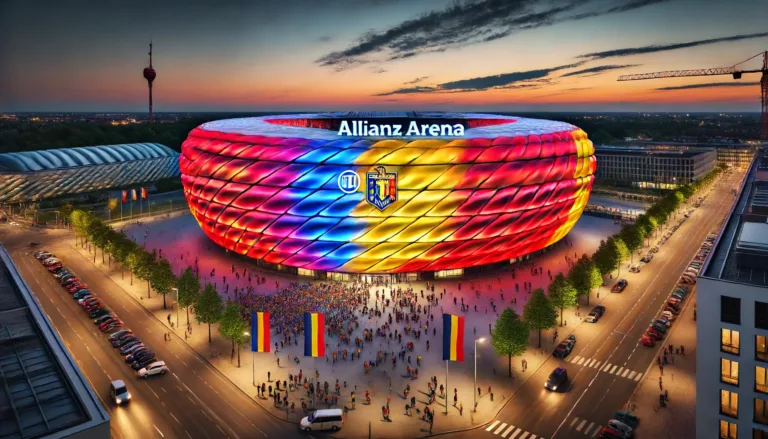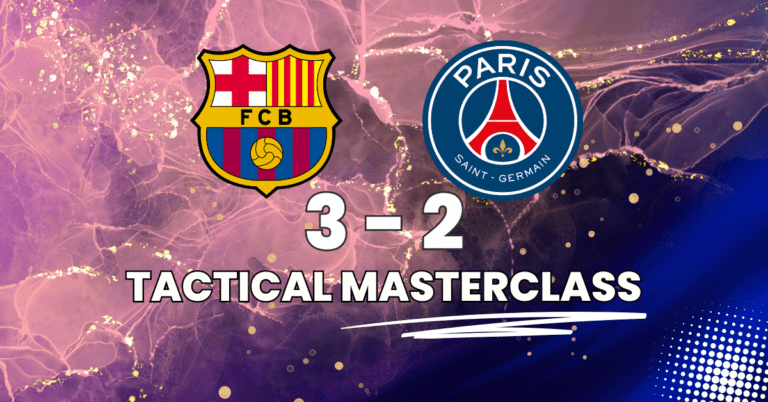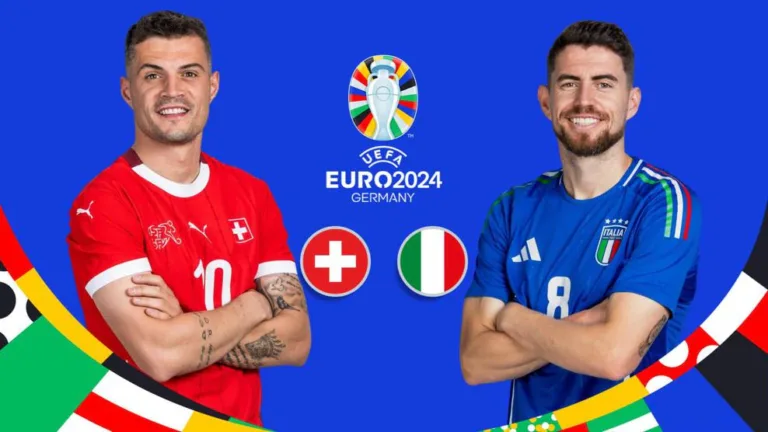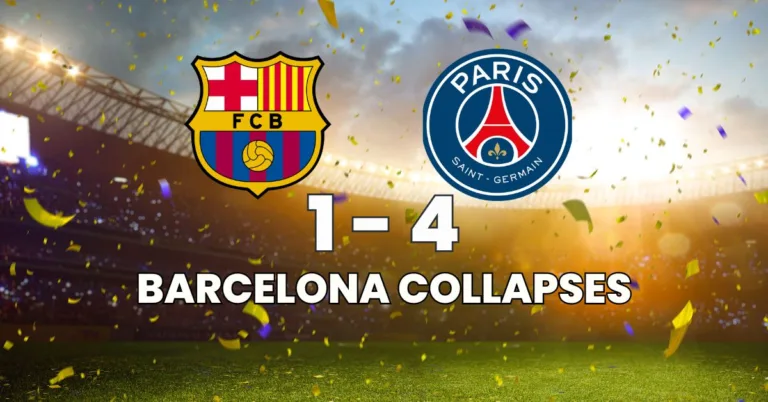Tactical Analysis: Romania Disappoints in Friendly Against Bulgaria (0-0)
Romania failed to grab a win against their neighbours, Bulgaria, in the penultimate preparation match before EURO 2024. Although it seemed like the team had things under control after the first half, they were unable to create significant chances. Unfortunately, for this match, we only have a few general team statistics and will not be able to delve into individual player performances.
Starting Lineups
Edward Iordanescu chose a 4-2-3-1 formation, which in practice, looked more like a 4-1-4-1, with Marius Marin as the defensive pivot and Răzvan Marin moving up to the midfield line.
This match marks the return of Nicușor Bancu to the national team squad after being injured for the last two friendlies, where the team struggled to fill the left-back position. Denis Drăguș took on the striker role in the absence of Denis Alibec, while Denis Man and Valentin Mihăilă played as offensive wingers.
Match Report
A Balanced but Uninspired First Half
The first half was marked by balanced play, with both teams trying to control possession and create attacking opportunities. In the 3rd minute, Razvan Marin entered the box and attempted to score with a shot towards the far post, but Bulgarian goalkeeper Ivan Dyulgerov made an easy save. Denis Drăguș had a great chance in the 19th minute when he received a perfect pass inside the box but sent the ball just a few centimeters wide of the right post.
In the 24th minute, the game was paused to provide medical attention to Razvan Marin, but he was not seriously injured. Later, Marius Marin received a yellow card in the 28th minute for a rough challenge on an opponent. Denis Drăguș remained active but played too aggressively, resulting in a free kick for Bulgaria in the 36th minute, which did not threaten Romania’s goal. The first half ended with a shot from Kiril Despodov from a mid-range free kick, which went just a few centimeters over the crossbar.
For Romania, the end of the half was marked by a major miss from Denis Drăguș, who was well set up behind the defensive line but failed to finish when one-on-one with the goalkeeper.

Bulgaria Goes on the Offensive in the Second Half
The second half began with Bulgaria controlling the ball and looking to find gaps in Romania’s defense. In the 51st minute, Dennis Man had the chance to score from a penalty, but Bulgarian goalkeeper Ivan Dyulgerov anticipated perfectly and blocked Man’s weak shot. Florinel Coman also came close to scoring in the 69th minute with a shot from the edge of the box, but the ball went just wide of the far post. The game grew increasingly tense as the minutes passed, with many fouls and interruptions.
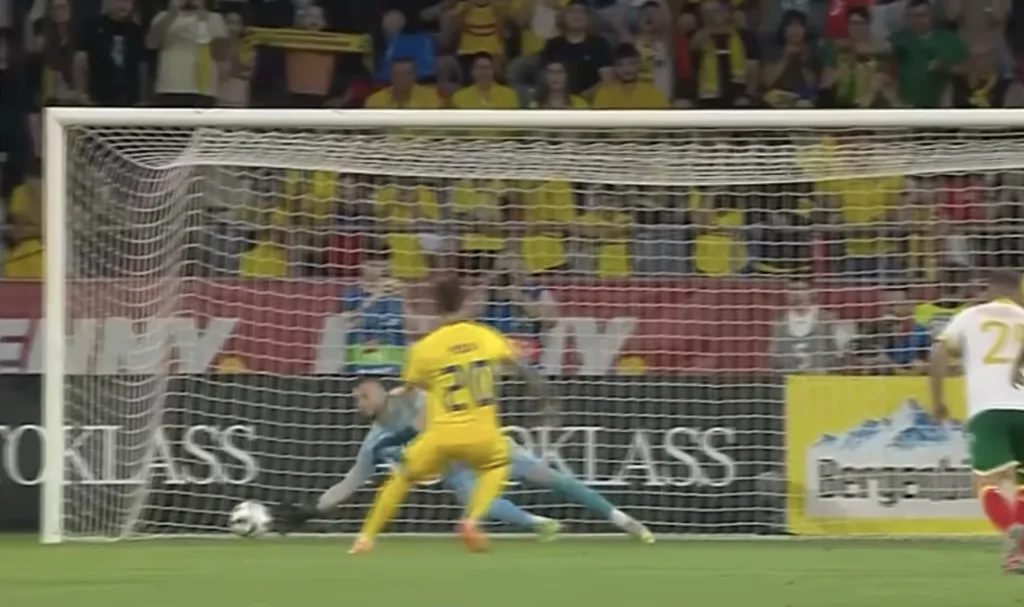
In stoppage time, Bulgaria continued to press but without success. Hristiyan Petrov took a shot from the edge of the box in the 91st minute, but the ball went well over the goal. Alex Petkov attempted a shot on goal in the 94th minute, but his effort was blocked. The referee blew the final whistle after 95 minutes, confirming a disappointing 0-0 draw.
Tactical Analysis
Romania’s Shape and Build-Up Play
In the build-up phase, Romania adopted a 3-4-3 formation with Drăgușin and Adrian Rus positioned on the flanks, and Marius Marin dropping between them to create a back three. This allowed Nicușor Bancu and Andrei Rațiu to move towards midfield, aiming to create a numerical superiority of 4 versus 3.
The team tried to draw Bulgaria’s aggressive pressing into the central area of the field to pass back to Niță, who would then send long balls to the wingers, either Dennis Man or Valentin Mihăilă. These wingers would drop back from the offensive line to pass to Nicușor Bancu or Andrei Rațiu, who could then advance into the space left open in the center of the field.
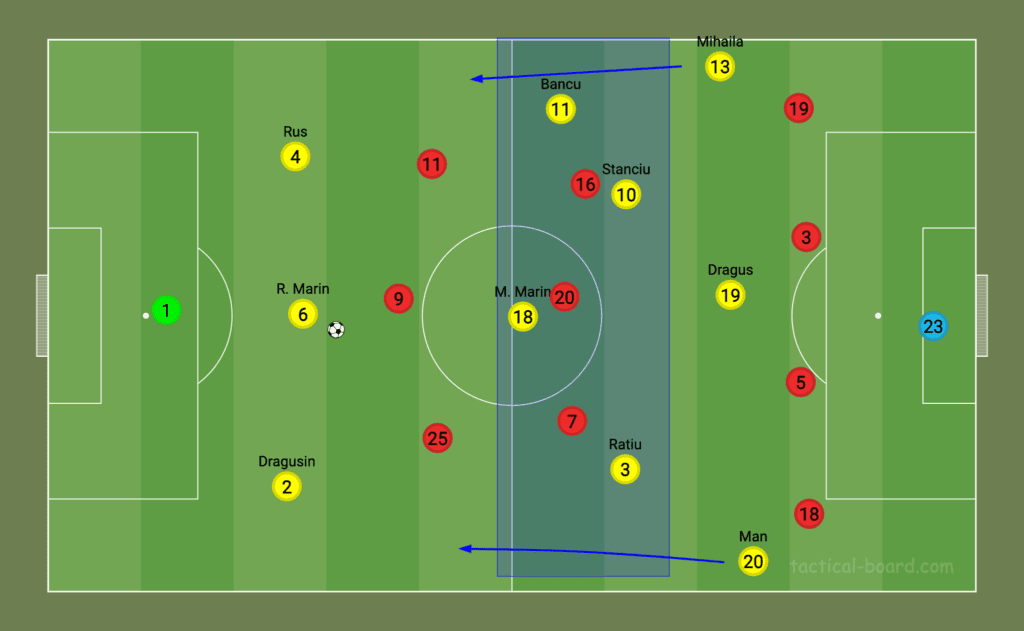
The Main Tactical Mantra
Another tactical theme observed in this match was Iordănescu’s adoption of a structure that spanned the entire width of the field, aiming to create spaces in the midfield.
Dennis Man and Mihăilă were consistently positioned wide on the flanks, while Rațiu and Nicușor Bancu moved towards the center into the half-spaces. Occasionally, these pairs—Bancu-Mihăilă and Rațiu-Man—would switch roles, with Mihăilă and Man cutting inside while Bancu and Rațiu maintaining the width.
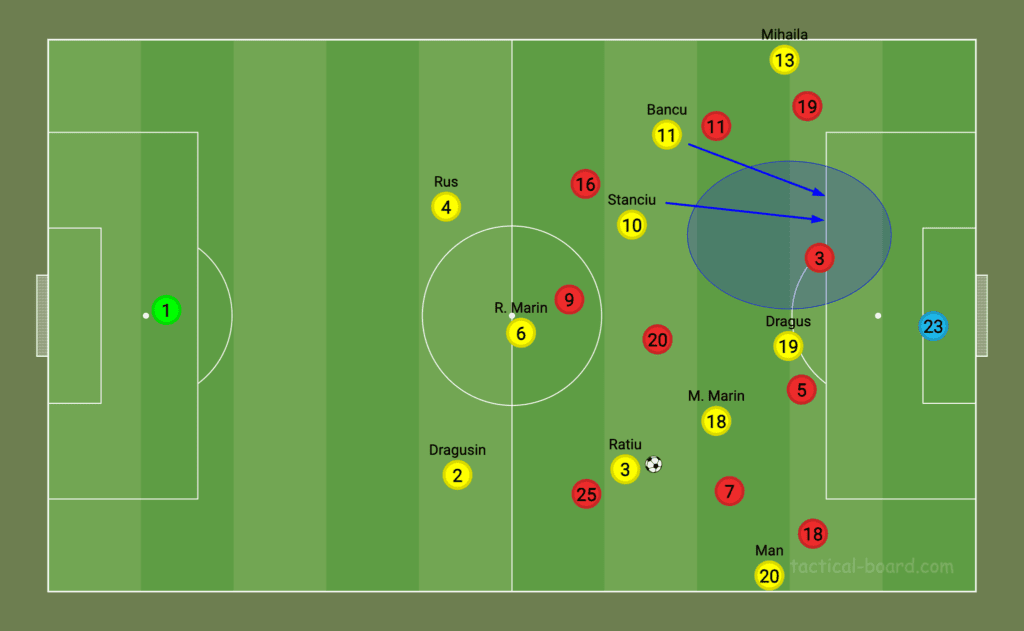
The issue with this configuration was the lack of speed and incisiveness from the team. Although they were effective in creating spaces in the central corridor, this space was not attacked often enough. Additionally, the defense had sufficient time to organize and close the flanks, preventing passing lanes into the open space.
Romania’s most dangerous moments came when the central space was attacked, with Stanciu or Mihăilă entering the box and exploiting the central area. This approach led to the penalty awarded to the team when Stanciu positioned himself well between the center back and the fullback, and Mihăilă, along with Drăguș, attacked the vulnerable space. However, as shown below, the gap in the center of the field was not attacked or occupied by anyone.
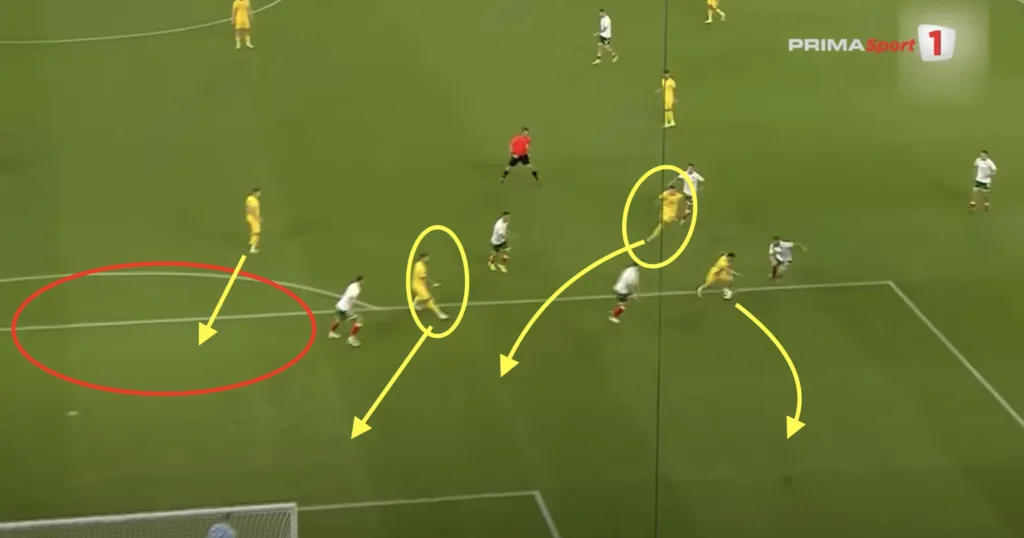
Romania’s Defensive Shape and Tactics
In defense, Iordănescu opted for a 4-1-4-1 structure with Răzvan Marin positioned between the defensive and midfield lines, alternating with a 4-4-2 formation when one of the midfielders, either Nicolae Stanciu or Răzvan Marin, moved up to press.
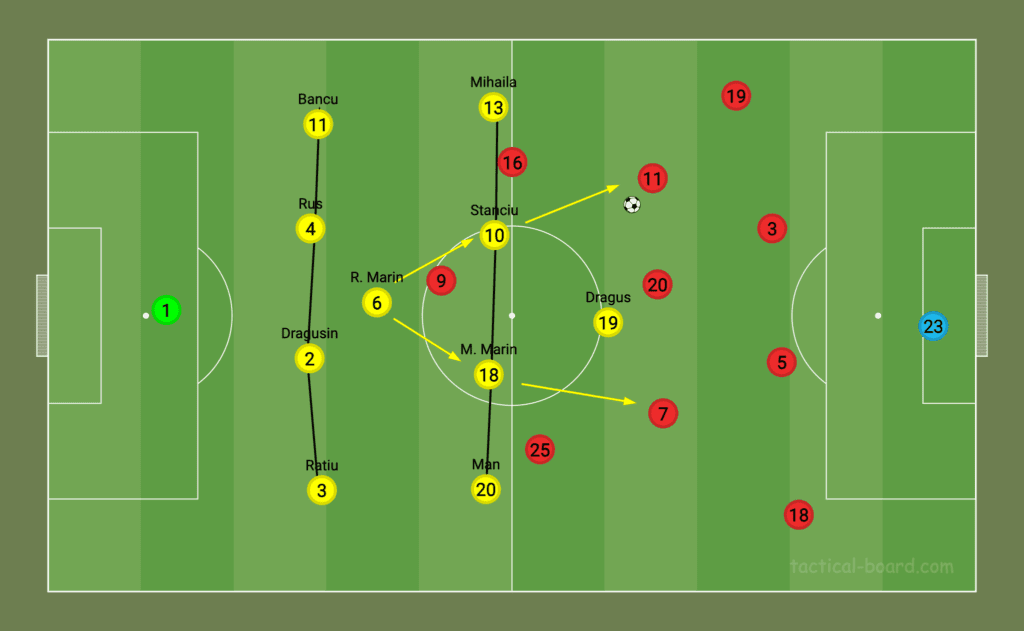
Overall, the defensive shape was quite solid, but it’s important to note that the Bulgarian team didn’t pose significant challenges. Their shots were generally weak and aimed directly at the goalkeeper. The defensive difficulties in this match stemmed from a lack of communication and chemistry among the players. There were two instances where Drăgușin and Niță failed to communicate effectively when clearing the ball, and towards the end of the match, Drăgușin created a dangerous situation for Romania with a pass to Niță, who had come off his line.
Conclusions
Overall, the match was a useful test for both teams, providing coaches with insights into areas needing improvement. Romania needs to focus on increasing offensive efficiency and developing better coordination among players.
The 0-0 result reflects a balanced game, which can be seen as somewhat disappointing since a victory for Romania was expected. However, we can hope that this match was just a step towards a more solid strategy and direction for Romania’s performance at EURO 2024.


